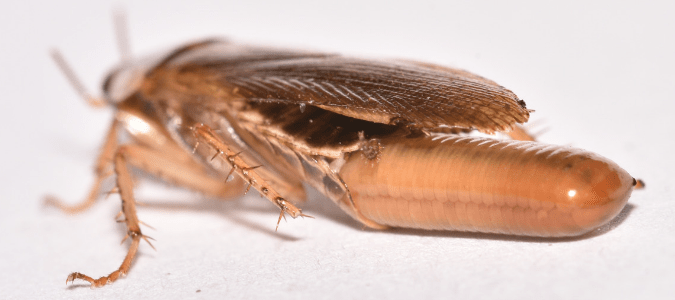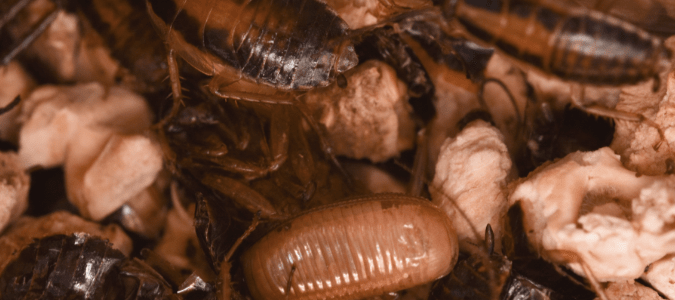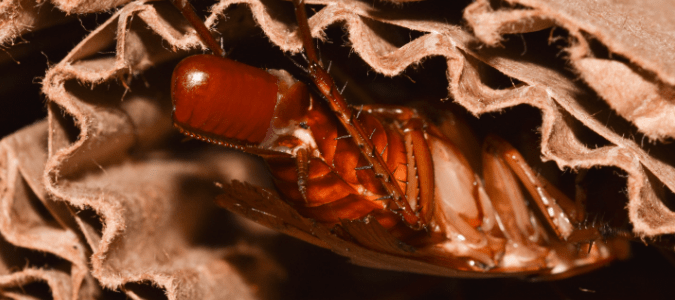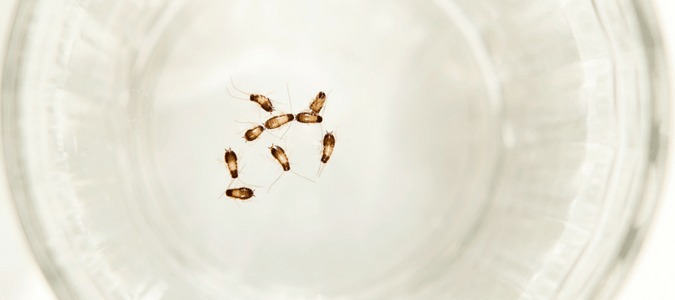
Cockroaches have been crawling across the Earth for quite a long time—350 million years, to be exact. That’s far longer than human beings have been around; in fact, roaches even predate dinosaurs. This hardy, adaptable species with incredible longevity is certainly disliked, arguably for good reason. Roaches spread bacteria including salmonella, streptococcus and staphylococcus, and they have been linked to health problems including asthma, dysentery and even polio. Their ability to feed on almost anything can also lead to extensive property destruction, as they will happily eat their way through cardboard boxes, books and magazines and even electrical wiring.
For all these reasons and more, it can be alarming to find roach eggs in your home, since the presence of roach eggs means that roaches are living and breeding nearby. If you think you may have found roach eggs, read on to learn about how to identify different types of cockroach eggs, how to eliminate roaches from your living space and how to prevent a full-blown roach infestation.
How To Identify German Cockroach Eggs
Of the 3,500-plus cockroach species that exist throughout the world, only about 55 species live in the United States, and only about 10 to 20 of those typically live indoors with humans. German cockroaches are the most common type of roach to live and breed indoors, in people’s homes and apartments (not to mention in office buildings and restaurants as well). German cockroaches can live just about anywhere humans spend lots of time because they thrive in a warm, humid environment near a plentiful food source.
German cockroaches are distinguishable from their American cockroach cousins by their size and color, and the same is true of their eggs. Adult German cockroaches are quite a bit smaller than adult American roaches, measuring about a half-inch long, and they range in color from tan to light brown. They have two darker stripes that run from just behind their heads down the length of their backs. Like all roach species, they have fully developed wings, but unlike many other types of roaches, German cockroaches can’t fly.
Similarly, German cockroach eggs are distinguishable from the eggs of other types of roaches. All roaches lay their eggs within small cases called oothecae that have a firm outer shell. German roach egg cases are smaller, narrower and lighter in color than those of American cockroaches, and typically measure about a quarter-inch long. Female German cockroaches often lay between 30 and 50 eggs at a time within one egg case.
Like all indoor roaches, German cockroaches are scavengers that can feed on everything from human and pet foods (and food waste) to books, cardboard boxes, glue, fabric and other materials that aren’t edible for humans. Since roaches lay their eggs wherever they nest, you might discover their egg cases in your kitchen cabinets, your pantry or under your refrigerator or stove; in your bathroom cabinets or near the sink; or in small cracks in flooring or near baseboards. German cockroach eggs can even be found in between layers of clean, folded linens inside closets—basically, any place where roaches can go, find food and set up a nest.
American Cockroach Eggs: Differences From German Cockroach Eggs
The (much) larger cousin to the German cockroach, American cockroaches are the other most common cockroach to be found living inside people’s homes, as well as in restaurants, offices and other buildings where humans spend time and prepare food. These are the type of roaches that many people call “waterbugs,” and they can and do thrive outdoors as well. Living indoors, however, offers them easy access to food, water and shelter, especially during times of year when extreme weather outside drives them inside in search of more temperate conditions.
American cockroaches range in color from medium to dark brown or reddish-brown. They can grow to a whopping two inches in length and a half-inch to five-eighths-of-an-inch wide, and unfortunately, their wings work—meaning, they can fly. They can also run—fast—which makes an American cockroach sighting a rather startling event, especially if you’re unlucky enough to have one fly into you or run over a part of your body.
An American cockroach ootheca is longer, wider and darker in color than the egg cases of German cockroaches. American cockroach egg cases measure about three-eighths of an inch long, and they are a medium brown color just after the female cockroach lays the eggs. Within a few days, the ootheca darkens, turning almost black. Each American cockroach egg case holds about 16 or 18 eggs.
Cockroach Eggs Hatching Time
Female German cockroaches lay an egg case about every six weeks, and it takes about four more weeks for the eggs inside to hatch into babies. Most female German cockroaches will lay between four and eight oothecae in their lifetimes, so a single female can be responsible for producing several hundred cockroach babies. Yuck!
American cockroach eggs take a bit longer than German ones to hatch; after a female American cockroach lays an ootheca, it takes about eight weeks for the eggs inside to hatch into babies. American roaches lay more oothecae in their lifetimes, however—up to 12—and they also have longer lifespans than their German cousins. Thus, female American cockroaches can produce hundreds of baby roaches in a single year, each of which might live three to four years in optimal conditions. Double yuck!!
Cockroach Eggs Size
When people wonder about cockroach eggs’ size, they are usually really wondering about the size of the cockroach oothecae—the egg cases that female cockroaches lay, which are filled with tiny eggs. German cockroach egg cases are typically about a quarter-inch long and less than half that in width, while American cockroaches lay egg sacs that are about a half-inch long and a quarter-inch wide. These cockroach egg sizes are proportionate to the cockroaches themselves; German cockroaches are smaller than American cockroaches, so it makes sense that their eggs are smaller as well. Nymphs start out small and gradually grow into adults.
Cockroach Eggs: One Common Sign Of A Roach Infestation
If you’re finding cockroach eggs in your home, whether in your kitchen, pantry, bathroom, cupboards or someplace else, it’s an indication that more—often many more—roaches are nesting someplace nearby. Along with roach eggs, here are some other signs of a German or American cockroach infestation:
- Cockroach sightings, whether living or dead.
- Roach feces, which look like tiny dark-brown or black spots on shelves, walls and other surfaces.
- An unusual musty odor that is distinct to cockroaches and their eggs and feces. A musty scent in a part of your home where you’ve seen roaches, egg cases or other signs of cockroach activity can indicate the presence of a roach nest nearby.
Any of the above signs can indicate a cockroach infestation, usually of either the German or American variety. Again, roaches are known to carry bacteria and spread diseases, and besides, most people find them startling, if not downright disgusting, to encounter. So if you suspect you have a cockroach problem, what should you do? What eats roaches? What about natural repellent options?
Many people try do-it-yourself methods first, to see if they can eliminate a roach problem on their own. You can experiment with different products created for residential use to see which is more effective at killing roaches. You can also purchase roach pesticide products in many forms, including traps, baits, gels and sprays and even foggers. These products may not be as appealing, however, to homeowners with small children or pets living in the house.
Aside from using products that kill roaches, keeping your home clean, especially in high-food-traffic areas like the kitchen and dining room, will go a long way toward keeping roaches at bay. It’s also important to fix any leaking pipes or other water sources, to eliminate roaches’ access to water.
ABC Can Eliminate Your Cockroach Problem
Got roaches? ABC Home & Commercial Services can help. If your roach problems prove to be beyond the scope of roach-killer products you can buy at the store, we will work with you to develop a plan to eliminate any roaches living inside your home as well as dealing with those that may be making their way inside from the outdoors. We have a variety of methods of eliminating roaches as well as roach eggs, including methods that are low-impact for children and pets while being effective in the long-term.
Contrary to popular belief, cockroaches actually do play an important ecological role as prolific recyclers. They can feed on almost anything, including dead plant and animal matter, animal waste and garbage. As they consume these various types of matter, their digestive systems break the matter down into nutrients that feed the soil. Roaches are also a food source for many types of insects and small mammals. Still, most people find roaches downright stomach-churning and having them as housemates is a decidedly repulsive prospect. If your home is infested with roaches, whether the German or American variety, or even tiny roaches, it’s time to call ABC. We will take decisive steps to get rid of these bugs so you can enjoy your roach-free home.




